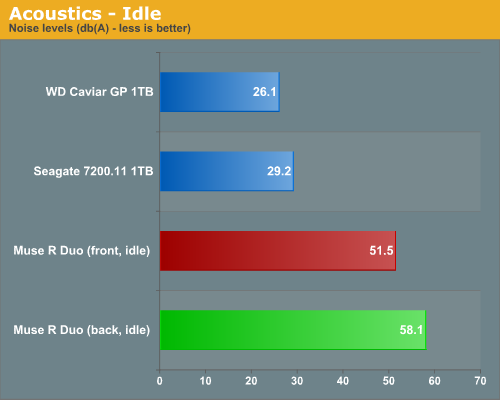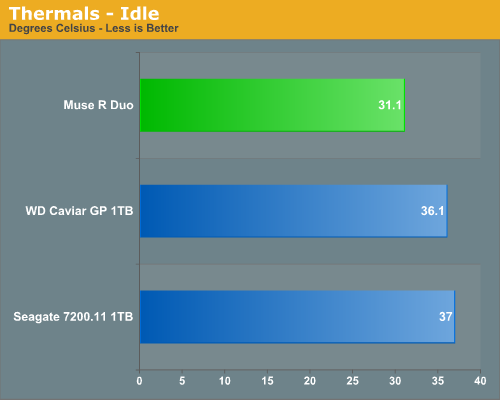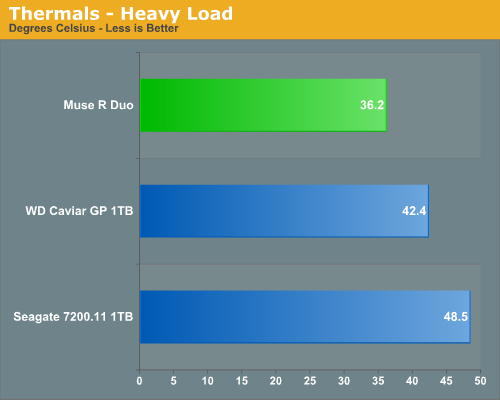Thermaltake Muse R-Duo: External RAID
by Dave Robinet on December 14, 2007 2:00 AM EST- Posted in
- Storage
Acoustics
As this is an external device, we are able to take advantage of long cable runs to ensure that the Muse R-Duo is in a physically separate room from the host computer. We will test the unit under drive operating conditions, as well as separately to check the noise levels of the Thermaltake cooling solution.
For the drive operating portion, our acoustic tests measure the decibel levels while the system is at idle and under load while running the General Hard Disk Drive Usage benchmark within PCMark 2005. We found through trial and error that this particular benchmark produces controlled readings across a wide range of applications within the benchmark. This particular benchmark utilizes 60% reads and 40% writes within the trace playback file.
We take measurements at a distance of 5mm from the rear and front of the enclosure in order to minimize surrounding environmental noise. We have noticed that unless we run a completely silent system in a quiet room that measurements taken from 1m are generally not meaningful due to ambient noise levels. There are exceptions like the Raptor series of drives but overall most modern desktop drives are quieter now than the other components in the system while under load.
The reported measurements use an A-weighted decibel score that measures frequencies similar to the way the human ear responds to sound. We take three measurements for each test. We then subtract the high and low scores and arrive at our findings by reporting the remaining score.


The Muse R-Duo is far from silent, with the small fan blowing a significant amount of air through the enclosure. The noise actually reverberates in the enclosure somewhat, making it that much louder. Even under heavy load, the fan completely obscures the sound of the hard drives.
Thermals
Our thermal tests utilize sensor readings via the S.M.A.R.T. (Self-Monitoring, Analysis and Reporting Technology) capability of the drives, gathered using the Active SMART 2.6 utility. Note that we upgraded from version 2.42, which we used in our previous tests; in re-running several benchmarks we were able to confirm that no results changed as a result of the update. We also utilize thermal sensors and infrared measurement devices to verify our utility results. We test our drives in an enclosed case environment without the fans operational to simulate running in a near silent SFF or HTPC case design. We typically find the reported numbers drop anywhere from 18% to 25% when the case fans are operational. Our base temperature level in the room at the time of testing was 25C.


The Muse R-Duo does a very good job keeping the two Seagate drives cool - its loaded temperature comes in beneath the idle temperature we observed in our normal benchmark procedure when testing the bare drive. Note again that we conduct the system test without case fans operational, so it reflects a far worse scenario. Still, having the hard drives run that cool while sitting nearly adjacent to each other is an impressive feat, and a testament to the pedigree of strong cooling that Thermaltake brings to the table. The acoustic results and temperature results are two sides of the same coin, of course: louder fans creating airflow reduce temperatures and a lack of fans and airflow causes them to rise.










11 Comments
View All Comments
Zak - Friday, December 14, 2007 - link
I've gone through 4 dual drive enclosures and concluded that anything with fan smaller than 80mm is too loud. They were usually louder than my computer so I don't expect this one to be any better. I've settled for SansDigital 4-drive USB eclosure in JBOD mode. Their 4-drive SATA is also a great value but I couldn't get the included SATA card to work properly neither under OSX nor Windows XP so it went back. But I'd like to see some reviews of SansDigital hardware, they have some nice offerings.Zak
MrPickins - Friday, December 14, 2007 - link
I'm sure I missed it when reading the article, but what type of connection were you using for the benchmarks?I'd assume eSATA, but I'd also like to see how the enclosure performs using the USB interface.
Dave Robinet - Friday, December 14, 2007 - link
Yep - eSATA was used. It's tough to imagine a lot of USB use for this sort of device, to be honest, so that wasn't tested.Thanks a lot for reading!
Magendanz - Friday, December 14, 2007 - link
I believe this unit uses the Silicon Image SiI5744 Storage Processor, which has frequent firmware updates and a decent utility called SteelVine Manager for configuring and monitoring the chipset. I purchased a similar unit called the ONNTO DataWhale from CoolDrives and have been very happy with it. (The DataWhale has removeable drive trays, which I like.)It's interesting to note that the SteelVine products have support for SAFE33 and SAFE50 modes (which split the drives into RAID 1 and BIG partitions) as well as an advanced GUI configuration mode that allows you to configure combined modes manually. On the DataWhale, this was enabled with an internal jumper and I'd expect the Muse also has this. Just pull the jumper and set the DIP switches to SAFE mode, then you can configure to your heart's content using SteelVine Manager.
Note: The latest version of SteelVine Manager requires the latest firmware update, but since SteelVine Manager is required to update the firmware this results in a bit of a Catch 22. Just install an older version of SteelVine Manager, install the firmware update, and then update to the latest version.
Yawgm0th - Friday, December 14, 2007 - link
The definition of RAID 1 listed in the article is not correct. In a standard RAID 1, the drives are mirrored and presented as a single volume to the operating system. However, they will both be accessed simultaneously during all read and write actions. This is why RAID 1 generally results in a substantial increase in read speeds but a slight decrease in write speeds.This is true if you are doing a software RAID, in which case the operating system or RAID software knows to do this, and with a hardware RAID, in which case the controller automatically reads and writes to both drives simultaneously. Anything else is not RAID 1.
The definition listed for RAID 1 in this article describes a behind-the-scenes backup, which is not RAID 1. If this is the case, it ought to be given more mention in the article. One of the biggest benefits to using RAID 1 is not just the high reliability, but the greatly increased read speeds. If the described method is what's in use, then it's a serious flaw in the device.
Dave Robinet - Friday, December 14, 2007 - link
The device does provide true RAID 1 in its normal sense. My choice of words was meant to illustrate the way the end-user sees the device, and it's substantially easier to say "show one device, then use the other".The reality of RAID 1 is that the OS reads from only one drive, so the basic definition is essentially true, though. I'll see about cleaning up the wording to satisfy both clarity and to make it more accurate. Good catch!
yyrkoon - Friday, December 14, 2007 - link
$143 usd is not a terribly large sum of money, but if you look into alternatives, you can get the addonics 2port port Multiplier, and do the same thing for cheaper. Then again, you'd have to either build your own enclosure, or buy one. I wouldnt be surprised if this device in fact uses the addonics port multiplier . . .All the above said, I would have to agree in wondering if RAID really has a place on the desktop(or most workstations and servers for that matter), as there are so many 'better' ways to store data safely without even using RAID in the first place. Database servers storing mission critical data MAY need RAID for an added form of reliability, but probably do not need RAID for performance, as any self respecting database admin is probably using a static ram HDD device, or possibly a large RAM disk(assuming balls out performance is even needed).
I cannot really help but wonder if a software RAID array, on a multiple core system would outperform this device or not. That and the fact with tools such as rsync, and just storing important files on multiple drives wouldn't be as safe, without the hassles/complications that RAID can bring into the big picture. The cost definately would be less . . .
cserwin - Friday, December 14, 2007 - link
I've had to explain to too many family members that their digital photos are gone-baby-gone because they haven't backed them up.I think RAID 1 is critical for digital photos.
ESATA give the advantage of allowing direct management of the photos on the redundant array without any appreciable loss of performance, and it is very portable for upgrades. It is way more functional than USB 'backup' solutions - especially for me, who gets the phone call when my uncle/mom/sister/aunt is having a problem.
yyrkoon - Saturday, December 15, 2007 - link
Sorry, but RAID 1 is not going to magically fix all of everyones problems. What happens if bobby-sue's kid deletes (a la shift delete) all their families image files, or disk corruption creeps onto a single somehow, while mirroring to the second ? Try explaining to a family that their Photos and other data files are bye-bye-gone after you recommended that they spend twice as much in HDDs plus controller(if needed).DeltaCopy:
http://www.aboutmyip.com/AboutMyXApp/DeltaCopy.jsp">http://www.aboutmyip.com/AboutMyXApp/DeltaCopy.jsp
Smart partitioning + DeltaCopy + offsite optical media storage may not be perfect, but is a good bit smarter than just adding another point of failure to a storage syst
Magendanz - Sunday, December 16, 2007 - link
Fortunately, Vista and Windows Server shadow copies prevents data loss in these scenarios.